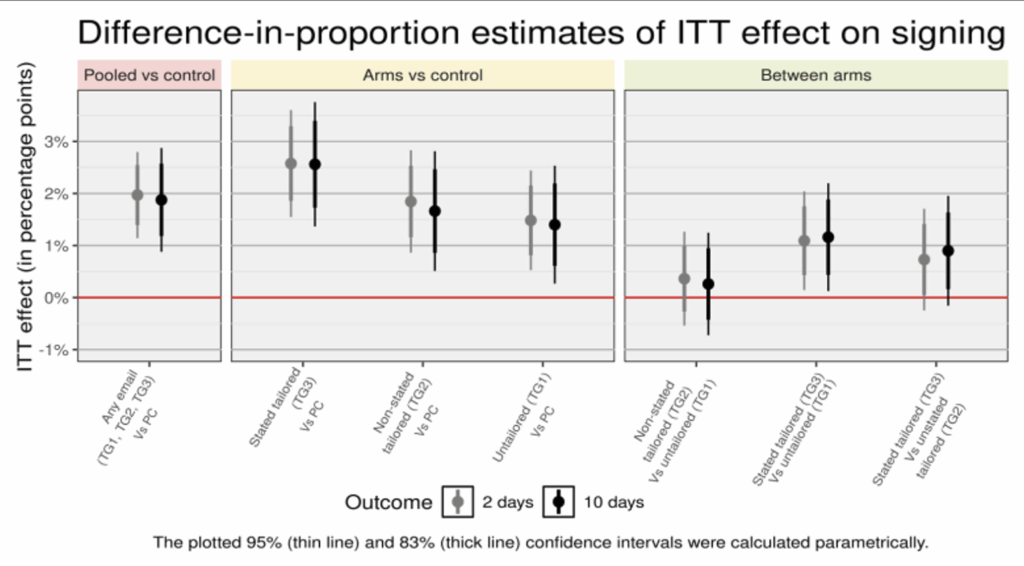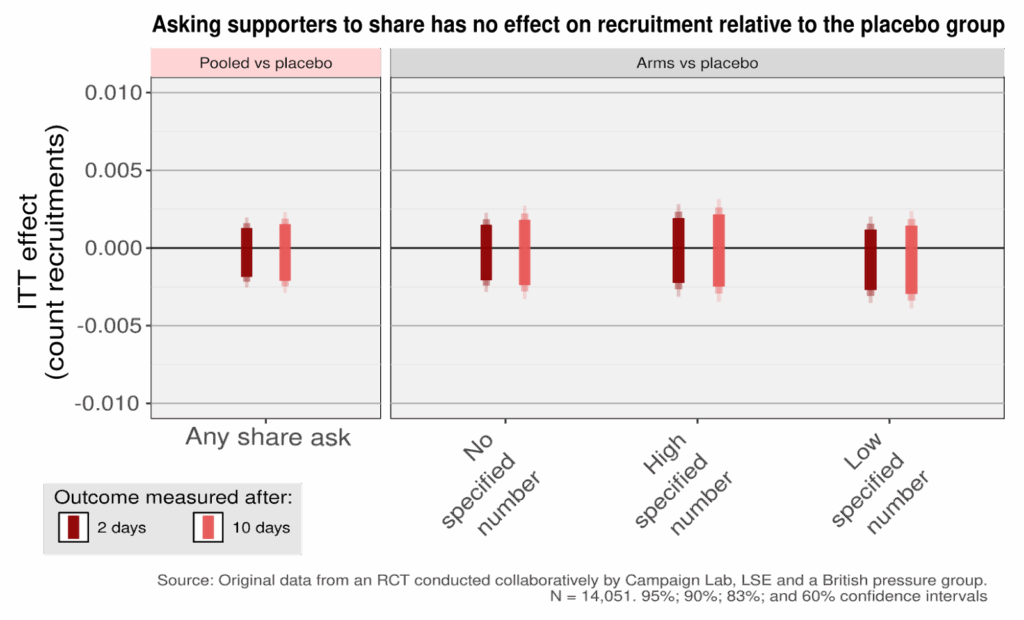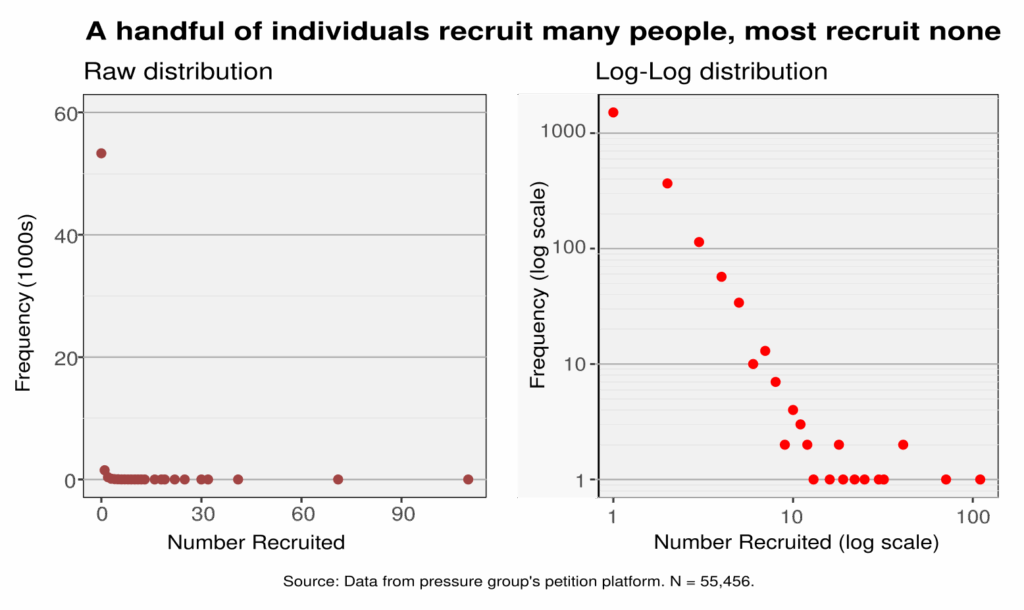Campaign Lab’s petition experiment found that explicitly personalised emails increased signing rates by 2.5 percentage points, outperforming generic messages, while standard recruitment emails had no measurable effect on persuading supporters to recruit others. Most additional signatures came from just 4% of participants, showing future relational campaigning efforts must find ways to engage a broader base beyond a handful of “superspreaders.”
In late 2024 Campaign Lab partnered up with an organisation to research different strategies for mobilising support for a petition. The aim of this project was identifying the most effective communications strategies for mobilising non-electoral political action with an engaged audience, as part of an ongoing development of relational campaigning.
Project description
Our project tested two tactics: tailoring messages based on individual-level data and mobilising supporters to recruit their social networks to action.
The tailoring experiment analysed the effect of message personalisation on whether someone signs the petition. To test this, emails varying in personalisation style were sent, some referencing a random issue, some referencing the addressee’s most important issue, and some referencing the addressee’s most important issue while also explicitly mentioning the personalised nature of the email. The sample consisted of over 11,500 people from the organisation’s mailing list who had not signed the respective petition already and the outcomes we measured were whether the recipient signed the petition after the email.
The recruitment branch of our project tested how different email requests impact supporters’ likelihood of sharing the petition. We did this by sending emails either generally asking individuals to share the petition, asking individuals to share the petition with a low number of other people, asking individuals to share the petition with a high number of other people, or just a general update email which does not ask about the petition as a control. Our sample size was over 16,500 individuals who already signed and the outcome we observed was the number of additional signatures generated through the subject’s unique share URL.
Findings and implications
In the first experiment, our findings show that there is some potential in tailoring messages. In general, we found that any email about the petition increases petition signing by around 2 percentage points, a relatively large effect for a single email. Messages tailored with the recipient’s most important issue which do not explicitly mention that the individual cares about this issue do not seem to have much of a different impact than an untailored email. However, emails which use an individual’s most important issue and explain that the issue was chosen because they had previously indicated it was important to them shows a better effect, of over 2.5 percentage points. The results suggest that personalisation of messages to supporters works when it is explicit. Referencing that the organisation took note of the subject’s political concerns in the email perhaps indicated that the organisation is listening and, therefore, led to a better mobilisation in terms of signing the petition.

The graph above shows that explicitly personalized emails were most effective at getting people to sign our petition. When we sent any type of email, we saw about 2% more signatures compared to sending no email at all. However, when the email mentioned that the message has been tailored to the recipient, this increased to 2.5%. This advantage of explicit personalized messaging was consistent both immediately after sending the emails and over a longer period. When comparing different email styles directly, customised messages clearly outperformed standard, non-personalized approaches.

Above graph: In terms of recruiting other individuals to sign the petition as well, the effects of asking subjects to participate are null. Our research has found that there is no significant difference in recruited individuals between the subjects that just received a general updates email and the ones that were explicitly asked to gather more people to sign the petition, regardless of whether they were asked to recruit a low, high, or unspecified number of people to recruit. Interestingly, our analysis has found that while most people do not recruit anyone, most of the new signatures are gathered by a handful of individuals who recruit a large number of people at once. Across the whole petition campaign, just 4% of supporters were responsible for all recruitments. These findings indicate that, while encouragement to political action via email could work in getting someone to act themselves, it does not help in motivating them to pass the message along to others. Our future research on relational campaigning will focus on how campaigns can move beyond reliance on “super-spreaders” and motivate a broader set of supporters to engage their personal networks.
In terms of recruiting other individuals to sign the petition as well, the effects of asking subjects to participate are null. Our research has found that there is no significant difference in recruited individuals between the subjects that just received a general updates email and the ones that were explicitly asked to gather more people to sign the petition, regardless of whether they were asked to recruit a low, high, or unspecified number of people to recruit. Interestingly, our analysis has found that while most people do not recruit anyone, most of the new signatures are gathered by a handful of individuals who recruit a large number of people at once. Across the whole petition campaign, just 4% of supporters were responsible for all recruitments. These findings indicate that, while encouragement to political action via email could work in getting someone to act themselves, it does not help in motivating them to pass the message along to others. Our future research on relational campaigning will focus on how campaigns can move beyond reliance on “super-spreaders” and motivate a broader set of supporters to engage their personal networks.

Graph above: Most petition signers did not bring in additional supporters. Looking at the data in both standard and logarithmic formats shows that while a small number of participants successfully recruited others, very few managed to bring in more than 10 new signers. This suggests that viral recruitment was limited, with most engagement driven by a few individual super recruiters.
Overall, there are significant prospects for message tailoring when trying to persuade people to engage in political participation. In our case, we found that tailoring the call to action when engaging with individuals already friendly to the cause, here taking the form of the partner organisation’s subscribers, increases the chances that individuals will mobilise, despite not being very effective in mobilising others alongside themselves.
Key Takeaways
- Personal messaging outperformed generic content, with explicitly personalised emails showing 2.5% higher engagement vs control
- Only 4% of supporters drove all recruitment success, highlighting need for broader activation
- Traditional ‘ask to share’ approaches had minimal impact – new models needed for viral spread
8 May 2025
